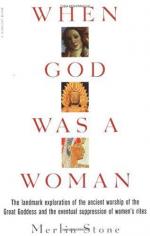|
This section contains 2,758 words (approx. 7 pages at 400 words per page) |

|
Chapters 10-11 Summary and Analysis
The Judeo-Christian image of woman personified in Eve motivates this study. Exploring the rites and symbolism of Goddess worship shows the Adam and Eve myth is designed to combat it and incorporates parts of the ancient dragon/serpent myth that has survived in the Psalms and Job. The "female faith" evolves gradually into an intricate tapestry that includes such symbols as serpents, sacred trees, and sexually tempting women who take advice from serpents. The Hebrew Paradise myth pulls together familiar images to teach women who once revere the Goddess why humankind is expelled from its original bliss in Eden.
Many peoples see existence beginning with a serpent, and the reason is probably not phallic symbolism. Throughout the Middle East, female serpents are revered for providing a link to "wisdom and prophetic counsel", not fertility. The Sumerian Goddess Nidaba, patron...
(read more from the Chapters 10-11 Summary)
|
This section contains 2,758 words (approx. 7 pages at 400 words per page) |

|




